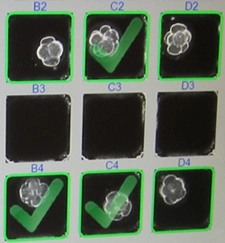
Auxogyn Seminar on Eeva
Embryo selection is no small matter in an embryology lab. Choosing high-quality embryos is critical to improving implantation rates, reducing multiple pregnancies, and improving pregnancy outcomes while reducing risk.
Continuing its development of new technology to assess embryo quality, Pacific Fertility Center (PFC) was the first embryology lab in the nation to install the Early Embryo Viability Assessment (Eeva) System from Auxogyn, Inc. Eeva is a time-lapse imaging technique that helps select the best quality embryos for transfer.
At the American Society of Reproductive Medicine (ASRM) Annual Meeting last fall, I was honored to moderate Auxogyns seminar, Predict Viability: Novel technologies to improve embryo selection, which presented Eeva findings to date. As the first lab to install Eeva in the United States, PFC is in a unique position to share our experiences with the system.
Lissa Goldenstein, President and CEO of Auxogyn, discussed development of the company its philosophy and history. The small company developed its technology here in the Bay Areain Menlo Parkfrom the ideas of Renee A. Reijo Pera, PhD, a master of theories on early embryo development. PFC worked closely with the company even before it existed, evaluating the technology and assisting Auxogyn on the development of the imaging equipment, culture dishes, and data interpretation and analysis.
Thomas B. Poole, PhD, from San Antonio, Texas, presented his work on other means of noninvasive embryo assessment, discussing techniques to measure embryo metabolism. Although this work is moving forward, predicting a quality embryo with metabolomics measurements remains problematic.
Marina O. Gvakharia, MD, PhD discussed her work with hands-on application of the Eeva system in her IVF laboratory in San Jose, CA. She discussed some of the unique cell division parameters that are useful in assessing embryo quality and showed how time-lapse imaging has helped in embryo selection.
Charles Kingsland, MD and Stephen Troup, PhD from the United Kingdom discussed their work in broad clinical application of the Eeva system. Eeva is approved for sale in Europe, and with the British HCFA regulations mandating a reduction in multiple pregnancy rates, Eeva has proven a useful tool in reducing the number of embryos transferred by selecting the best quality out of an embryo batch.
The session was attended by physicians and scientists from North and South America, Europe, and Asia. An enthusiastic question-and-answer session followed the presentations. There was broad agreement that embryo imaging technology is a significant advance in the assessment of embryo viability.
Embryo imaging, using time-lapse video, adds a new dimension to Pacific Fertility Centers technology repertory. Embryo imaging techniques will improve outcomes of IVF treatment, with better success rates, higher implantation rates, and reduced risk. We are pleased to join with Auxogyn, Inc. to further our goal of helping our patients build families, one healthy child at a time.
Note: Eeva is available in the EU only at this time and limited by US law to investigational use only.
- Philip Chenette, MD
View Dr. Chenette's Google+ Page »
Categories
About the Blog
Welcome to the Pacific Fertility Center Blog! Nationally and internationally recognized for providing exceptional reproductive care, our team believes in empowering people with the knowledge they need to navigate their unique fertility journeys.
From information on the latest fertility treatments to valuable insights on egg donation, surrogacy, and everything in between, the Pacific Fertility Center Blog is your ultimate resource for all things reproductive care and support. Read on to learn more, and contact us today if you have any questions or want to schedule a new patient appointment.

